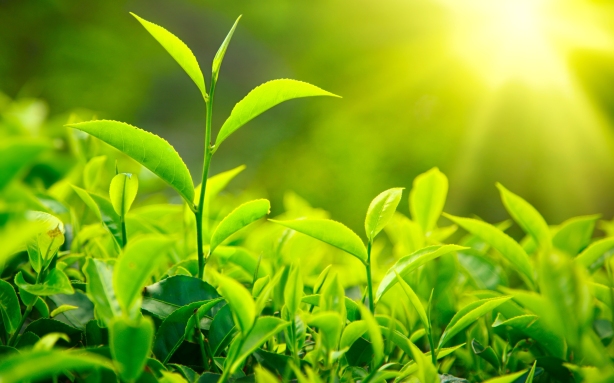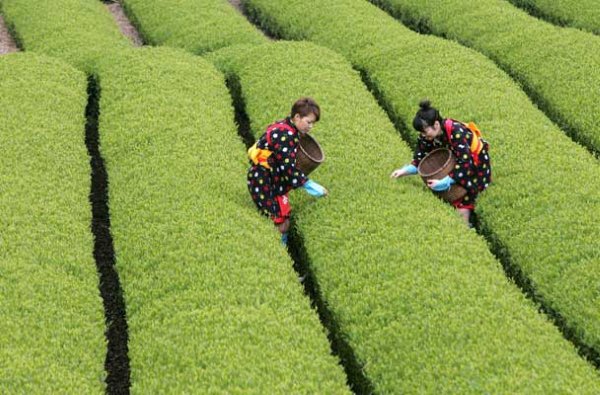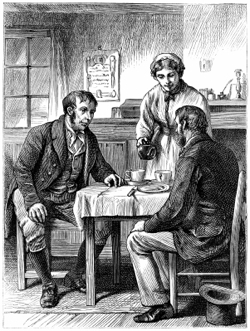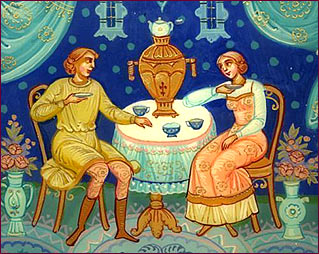










From the hidden archives and covered annals of History, falls the troublesome tale of Tea, Camellia Sinensis, or as they called it in China, cha.
Like coffee beans, vanilla cane, cacao beans, sugar cane, yerba mate leaves and coca leaves, this light and soft, green leaf – delivers a nice energy kick for its users.
An important question elicits some response: how did such a distant Asian plant change the course of world history, and yet transform so many cultures – and even those far off lands where it is impossible to grow such a plant?
The answer lies not so much with the plant – but with the historical traders who have profited off such a traffic. Whether trafficking in human slaves for plantation death work, opiates for achieving quick deaths, high-tech weapons for creating more wars, psychotropic meds for encouraging more mass killings, or processed meats for allowing more efficient slaughterhouse floors – the trade in spices and herbs does engender some peculiar benefits.
It was not the spice-herb itself however. The human actions of traders changed everything through their cravings and desires for greater and faster profits. They have been the ones who have manipulated the prices, achieved monopolies, and pressured states to go to war over such rights of monopoly and the free trade of capital.
All of this rancid progress implied cheaper commodity prices across the board, and even cheaper wages for the unfortunate worker slaves on the plantations. Most importantly, all of their outrageous profits thereby insured the capitalist owners their legal rights to join the slothful, aristo-parasite club.
In the 1830s, one of the world history’s greatest colonial kidnappers, transporters, slave masters and mass murderers of Africans, the British Empire, had just recently ‘freed’ its slaves in the West Indies. Their West Indian, or really Caribbean, colonies represented Guyana, Jamaica, Barbados, Antigua and a whole other list of little islands that were nothing more than African extermination centers located in the Caribbean.
Like the other mass murderers of Africans, such as the Portuguese, Spanish, Dutch, French, Danish and American Empires, the British authorities widely celebrated their so-called ’emancipation from slavery.’ The slave rebellions and escapes were too much to handle – although they never admitted this. The colonizers always stated that their abolition of slavery was due to their European benevolence.
Through such colonial benevolence, those same European authorities refused to offer any help to the former ex-slaves. The ex-chattel dregs received no property, money, housing, food or anything – instead the authorities always compensated the wealthy slave-plantation owners and traders.
The ex-slave had thus transformed into the new criminal class of the lumpen proletariat, last hired, first hired – and only offered the worst jobs in regards to both pay and health dangers. If the ex-slave, the newly minted criminal, dared to protest, strike or riot, then the local military or paramilitary police forces would simply shoot and murder them like exterminating rabid dogs. This is what happened in such ex-colonies as Jamaica, Brazil and Louisiana during the mid to late 1800s.
As a historian, there was always another driving concern in regards to the whole abolition of slavery myth. Why did certain European and Euro-American powers legislate emancipation at different times?
The Brazilian Portuguese and the Spanish Cubans legislated emancipation of the slaves in the 1880s. The French legislated final slave abolition in the 1840s. The British did it in the 1830s. What happened in the 1830s? Britain’s imperial possessions in other parts of the world can add some understanding to the general history.
At this same time in world history, the British began their colonial-imperial moves to control the entire international tea market.. They had also become the greatest drug dealers in world history. The British Empire would steal both the tea production and some seeds from China. Next, they would produce the Chinese tea on large plantations in northern India and Ceylon, (the island of Sri Lanka, off the southern tip of India), while using slave labor, or ‘coolies’ from all over South Asia.
The British Empire would soon cultivate another crop of poppy plants on their same colony of India, soon called ‘The British Raj’ in order to sell the product as black opium paste to the unwary Chinese, and thereby make millions off the addicts, while creating a permanent client base of junkies. With the abolition of slavery in the British Caribbean, the British Empire could coerce poor Asians to immigrate to the Caribbean in order to work as coolie slaves on the sugar plantations. The island of Trinidad was the worst of the lot.
The ingenious British capitalists and colonial officials had both corralled ready consumers and ready slave workers on three different, separate continents!
British tea drinking would become cheap and widely accepted in Victorian British culture, with even the British royal court having its ‘afternoon tea time.’ Tea converted into the cheap rage for all of its social classes: the aristocracy, the middle class who always aped them, and even the new working classes, who had to work so many hours that they had no time for proper meals. Tea breaks and drinking class time at the pub would often suffice.
Meanwhile, back in India, all the tea plantations had imprisoned slave workers, often worked to death, while others just died of disease.
Tea, or the milky chai stuff with masala spices, had also become a new fad for the Indian colonial collaborators, or ‘the civil service.’ These same people would take over the Indian state after their so-called, ‘independence-emancipation’ in 1948.
In China, plagued with its British ‘trading ports,’ such as Hong Kong and Shanghai, the colonizers had stolen the tea secrets, broke the Chinese tea economy, and at the same time, the Brit colonial merchants were drugging millions of Chinese with the opium poison cultivated in India!
Many displaced Chinese farmers had to look for work across the globe, and so they became the new coolie wage slaves found in the American west, in Andean South America, and often transported on flimsy work contracts to work on the other British colonial possessions, such as Malaya, in the Indochina region.
Tea is a light and bitter-tasting green leaf that alleviates against torpor and sloth. Often ground into power with water, or oxidized into a black dried leaf and sipped with deep creamy spices, camellia sinensis, offers an airy release to the doldrums of living life. It is a drug, but not even close to the power of soft drugs. Tea simply refreshes the mind from its constant struggle against inertia.
Tea’s history is ancient another story altogether. Always precious within the Chinese Middle Kingdom, Chan/Zen Buddhist monks, of the Mahayana persuasion, regularly used and extolled tea’s virtues in helping keep the monk focused, while persevering between meditation sessions. Monks in Korea and Japan also imbibed the grounded, powdery tea leaves. Soon an entire mindful ceremony revolved around the use, presentation, and sipping of tea.
Unfortunately for tea, European military colonizers and the dishonest merchants of capital had also spotted uses for the plant. They perceived tea not as a universal drink, but as a commodity for control, monopoly and export – and in the final product, a windfall of profits for their perverted dreams of laziness.
To live – and to never have to do any hard work again! Due to all of their gnawing cravings and desires for profit, the merchants of capital a would perform any crime imaginable for its conquest: theft, lying, disreputable livelihoods, profiteering, enslaving, and of course, murder.
The British colonial cloak and dagger plot goes even deeper. In the 1830s, The Royal Horticultural Society hired a Scotsman, dressed in Chinese mandarin garb, like the Italian Jesuits about 200 years before him, to spy out the production of tea in China. This man, a Mr. Robert Fortune, (yes, that was his real name), was able to take copious notes and grab lots of seeds. He even transferred his loyalties to a more ominous entity, The British East India Company. And yes, this was the same notorious outfit that got its tea monopoly taken care of during the 1770s in America, and lead to the revolt there, i.e. the Boston Tea Party!
Fortune did make his Fortune for both him and his East India Company. By, the 1840s the British had established tea slave plantations in Assam and Darjeeling, and when their coffee production scam fell through in Ceylon, the British switched to tea down there. Is it not a coincidence that the British Raj of colonial India began in 1848.
The British had a hard time in rounding up coolie, indentured slaves for their plantations, so they imprisoned them inside those hellholes, and would not pay them in coin. Instead, they gave out scrap papers, which made them debt slaves to the ‘companies.’ The British even refused to supply clothing, housing – and even food. Most of the slaves would die through overwork and disease. There were many escapes. One slave plantation owner actually sent a local paramilitary force to murder the escapees.
All of this happened. Even Indian official history refuses to tell the horrid details. Maybe because their great, great grandparents helped their own British overlords in committing the mass imprisonment and mass murder.
The British Empire was always expert in the importation of foreign workers. The locals knew the dangers of working on their tea plantations, so the British colonials brought in unwary Nepalese. In Ceylon, modern Sri Lanka, the Sinhalese would not work to die on those plantations, so the British imported Tamils from southern India to work as slaves. The British then snubbed the Buddhist culture of the Sinhalese, and so they purposefully fused the tensions between the two communities leading to the recent Sinhalese extermination of the Tamil communities in Sri Lanka.
Is not absurd that in many of the places where the British had recently colonized, they have also left legacies of hate and murder between once peaceful communities: Sri Lanka-Tamil Nadu, India-Pakistan, Ulster-Ireland, Jordan-Palestine, Iraq-Gulf States, Canada-Quebec, Malaysia-China, Egypt-Sudan, Iraq-Iran, Afghanistan-Kashmir, Kenya-Uganda, Myanmar-Burma, Australia-Aboriginal Reserves, South Africa-Boer Afrikaaner States, New Zealand-Maori Treaties, Rhodesia-Zimbabwe and Biafra-Nigeria?
And so it goes – the British Empire triumphed in their devious schemes to become the biggest tea importer monopolists around the world. We have only to look on the contemporary tea names of Lipton, Tetley and Twinning, to uncover their devious works.
The British ultimately ceded their port colonies to Chinese control – and the British lost America some 200 years before. Both the British and Indians are now milky tea drinkers. Tea has become part of their cultures – inclusive of cricket and lackadaisical civil service bureaucracies. Absurdity is everywhere and the Six Truths of History still reign supreme.
Tea has not just changed the cultures of China, Korea, Japan, India, Sri Lanka and Britain. Russia has also adopted tea drinking and its rituals with the samovar instrument to pour the stuff. Russian tea drinking actually became an integral part of its culture around the same time as British culture embraced tea, during the nineteenth-century.
Islamic medieval civilization had been enjoying the bittersweet and light brews of tea with little marzipan cakes for a thousand years before the Europeans began to monopolize the trade. They were the first merchants of both tea and coffee, and never did they pine to control the entire tea market.
In the Maghreb and the Sahel of North Africa, a marvelous tea culture has emerged among all the different nations that live there. Once the tea sits in the metal tea container for at least ten minutes, called a tetería in Spanish, then the pourer throws the first cup to the floor, which flows with loose grains. This is the cup for one’s enemies. Next, comes the first pour of hot tea around the table, and often between friends, which represents the fiery power of youth. The second round of tea usually has sugar added to it. This round signifies life’s sweet moments of love, family and one’s mastery of work. The third oblation is the final one. This last drink has a more lukewarm, grainy and bitter flavor to it. The last libation represents the bittersweet taste of life leading to old age, illness and death.
Still to this day, wage slaves in India work to death on those same British tea plantations. Now, it is the Neo-colonial State of India that encourages the murder of its own citizens. Tea retains its sacred position in Chinese universal culture, which includes calligraphy writing, distinctive stupa architecture, sublime intellectual masters, paintings on silk, pious Buddhist monks, five thousand years of history, and exquisite porcelain china.
Thanks to America, and especially to the Boston Tea Party of 1773, which helped move the American Revolution along, most modern tea drinkers use tea bags in their cups. In the American Southland, they prefer iced sweet tea, or mint julep tea, to the warm black-milky stuff.
Camellia Sinensis sits on tables across the Earth and remains a prisoner to the tea corporations that want us to purchase their products. They are all distinctly displayed on most supermarket shelves across the globe. We can visit China, Korea and Japan in order to taste the powdered organic stuff – and yet even there – tea still sells on the marketplace.
One can grow tea, but it only flourishes in particular oceanic-moderate climates. Every time we pour another cup, let us stay awake, keep mindful, and live with a mind well-freed – while we shall always remember its absurd, brutal, sad history.